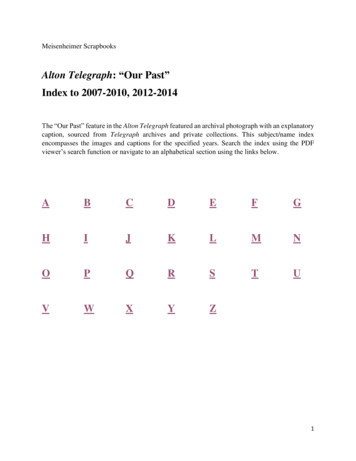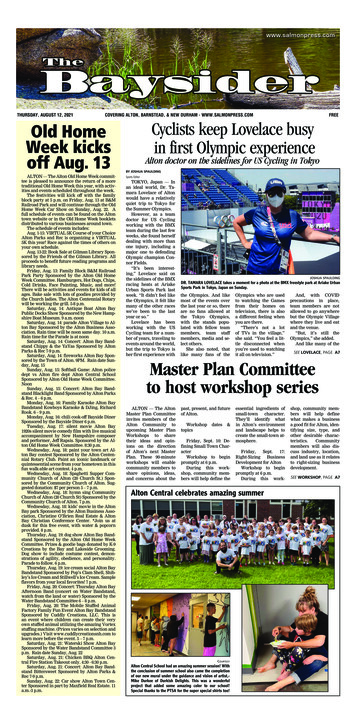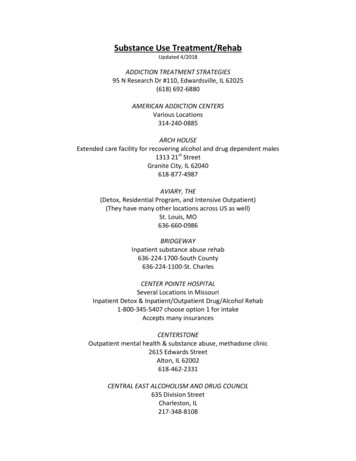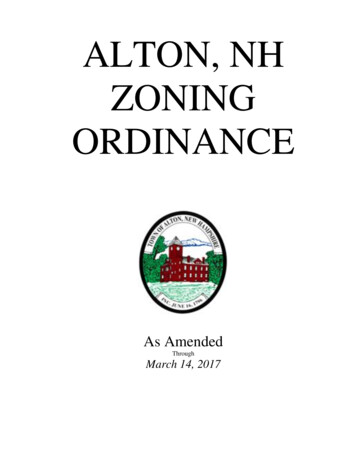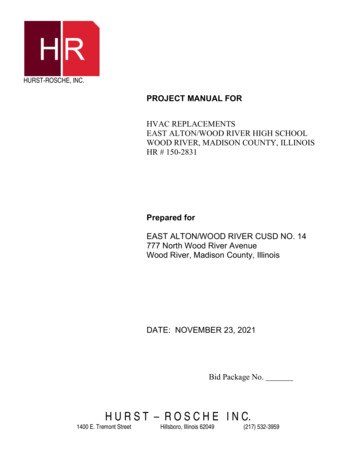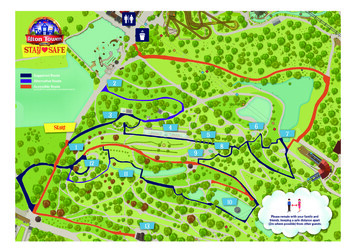
Transcription
Self Guided Alton Towers Garden TourPlease Note: These gardens have steep and rocky areas. Please keep to the paths at all times. Someareas are unsuitable for pushchairs, wheelchairs and those with reduced mobility. For pathwayssuitable for wheelchairs please refer to the map.Alton Towers Resort, the UK’s number one theme park, consists of 500 acres of superbly landscapedgrounds with original and spectacular gardens complementing the extraordinary collection of ridesand entertainments. Leaving the enormously popular amusements aside there is much for the visitorto enjoy in the extravagant gardens created by the 15th Earl of Shrewsbury and his nephew JohnTalbot, the 16th Earl, in the 18th and 19th centuriesThe amazing Chinese Pagoda Fountain, the Bath Fountain with its pond containing the figure ofTriton blowing water through a conch shell, the gilded domes, plate glass and galvanised ironstructure of the enormous Grand Conservatories contrast with the quaint Swiss Cottage and therestful Le Refuge. Scattered throughout the gardens is a fine collection of statuary, much of it withclassical allusions designed to add to the cultural and artistic ambience.Much restoration is currently going on in the gardens in an effort to stay true to the Earl’s vision. Itis interesting to remember that at the time of planting, the trees that you see now were just saplings,and it is thanks to the artistic talents of the 15th Earl that we can enjoy the magnificent gardens asthey appear today.For information, the water that supplies the various features, lakes, cascades and fountains comesfrom natural springs in the nearby Weaver Hills and so their flow is dependent on natural waterlevels.You will notice on this tour most of the garden buildings are on the left side of the valley. The reasonfor this is that the principle carriage-drive ran along the top of the ridge, and visitors were treated toa magnificent view of the gardens below before the house came into sight. All designed to impress!1To begin your tour the scalloped wall will be on your right. Followthis pathway through the iron gates and on the left you will see theQuarry Green House or Orangery, beyond these features is“Stonehenge”, so called because of the large stones used to build it.It bears no resemblance to its namesake!2Should you wish to see Stonehenge continue along this pathwaytaking a left at the fork then retrace your steps back to theOrangery to continue with this tour.
3At the far side of the orangery take the stone steps to the right-handside. These will lead you down to the Lion Fountain. Follow thepathway down the next set of steps and take a left and head downtowards the Conservatories.4The Conservatories were completed in 1824, the gardenConservatory has seven glazed domes, and pineapple finials.The central dome is topped by an earl’s coronet.In 1834 the 16th Earl managed to grow bananas (in those daysconsidered an exotic fruit) at Alton and sent one to the Duke ofDevonshire at Chatsworth together with detailed instructionson how to eat it!5At the end of the path is a domed stone structure – ideal forcooling off in hot weather or sheltering from the rain! Throughthe window is a delightful view of the Yew Arches. From here headdown the steps behind the domed structure and head through theYew Arches.From this point onwards you have a choice:6&7If you wish to see the Screw Fountain and Prospect Tower,simply walk forward and take the ascending stone steps to your left.Beyond the tree at the top of the steps is the Screw Fountain.Continuing along this pathway to the right and ascending the stepsto the left will lead you towards the Prospect Tower.Once at the prospect tower you will be able to take in some of themost breath-taking views on offer within the gardens.Following your visit to the Prospect Tower descend via the stonesteps behind tower. At the bottom of these step take the leftpathway before turning right at the stone steps. At the fork takethe lower path which will lead you down to the final Yew archto re-join the tour.
8&9Take the steps down from the final Yew arch where you will findLe Refuge, Bath Fountain and The Colonnade. In the mid-1800sit was considered beneficial to the health to take cold bathsthroughout the year.A Coadstone statue of a triton blowing into a conch shell originallytopped the fountain. To the right of the Bath Fountain is Le Refuge– with a chimney vent on one side of the door and an air-venton the other – which was used before and after the bath.From this point descend the next two flights of steps at thebottom of which you will see to your right the Bandstand.10To continue with this tour, turn left continuing down this pathwayuntil you reach the stone steps on your right which will bring youto the Pagoda Fountain completed in the 1830s.The recently completed restoration of the Grade II* Listed(Chinese) Pagoda Fountain at Alton Towers Resort, Staffordshire.The 3-month restoration involved specialist surface blasting,iron work restoration and painting.The (Chinese) Pagoda Fountain was completed c. 1832, designed byRobert Abraham. It is a three storey, octagonal shaped, painted castiron structure with Chinese hanging lamp bells, on an octagonalWhite Hollington sandstone base. The cast-iron structure wasmodelled on the To-ho pagoda in Canton, Southern China and madeby the Coalbrookedale Iron Company. From the point of the Pagodacontinue along the pathway. At this point again you have a choice:11You are now climbing the side of the Rock Garden.Note the Royal Ferns along the water’s edge.
12From this point we are heading towards the Choragic Monument,erected by the 16th Earl of Shrewsbury in memory of his uncle,Charles Talbot, the 15th Earl, who transformed the gardens froma barren wasteland, inhabited only by rabbits, into the magnificentgardens we see today and “made the desert smile”.There are two routes available. Either continue along the pathwayto the right, alternatively cross the steppingstones located to yourleft and continue along this route.The box hedge at the foot of the monument is in the shape of theletter “S”, the pattern for which was taken from one of the fireplacesin the house. Originally, the area surrounding the “S”, now coveredin gravel, would have been filled with “grog” – a by-product of thepottery industry.At the monument continue under the white bridge and lefttowards our grand historic house.13Follow the right-most pathway down towards The Swiss Cottage.The Swiss Cottage was originally built to house the Earl’s blindharpist, Edward Jervis who was commissioned to entertain hisguests who took leisurely strolls in the gardens.A visit to the Swiss Cottage is worth the trip should you wish to takein some stunning panoramic views of the gardens allowing you to seethe majority of main features mentioned within this tour.Following your visit to the Swiss Cottage retrace yoursteps back to end your tour.
(Chinese) Pagoda Fountain at Alton Towers Resort, Staffordshire. The 3-month restoration involved specialist surface blasting, iron work restoration and painting. The (Chinese) Pagoda Fountain was completed c. 1832, designed by Robert Abra
